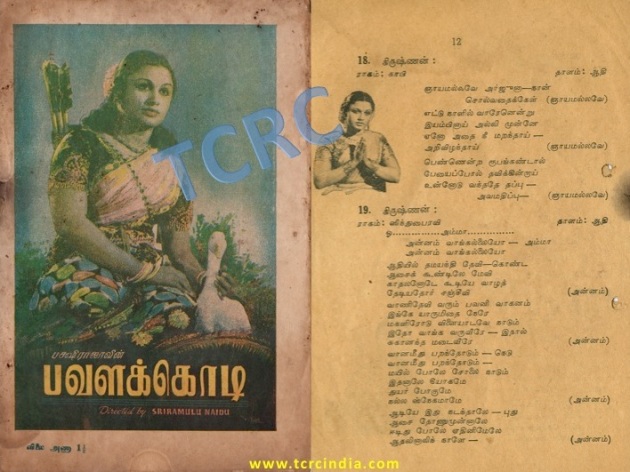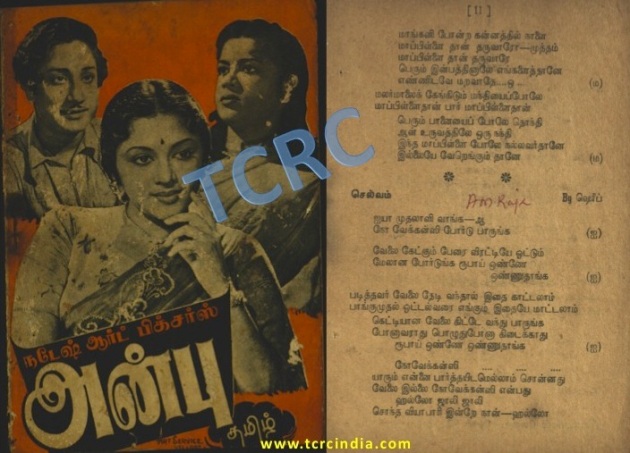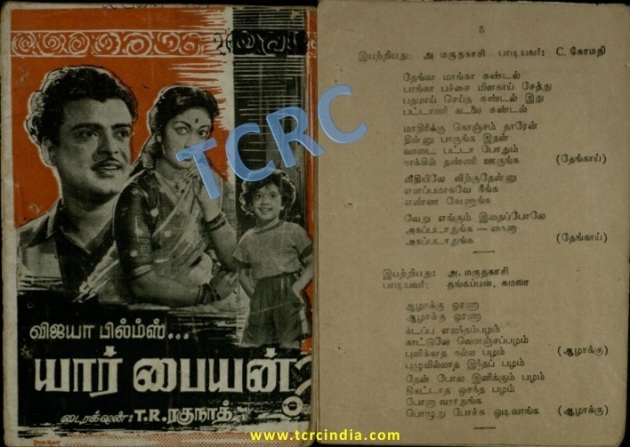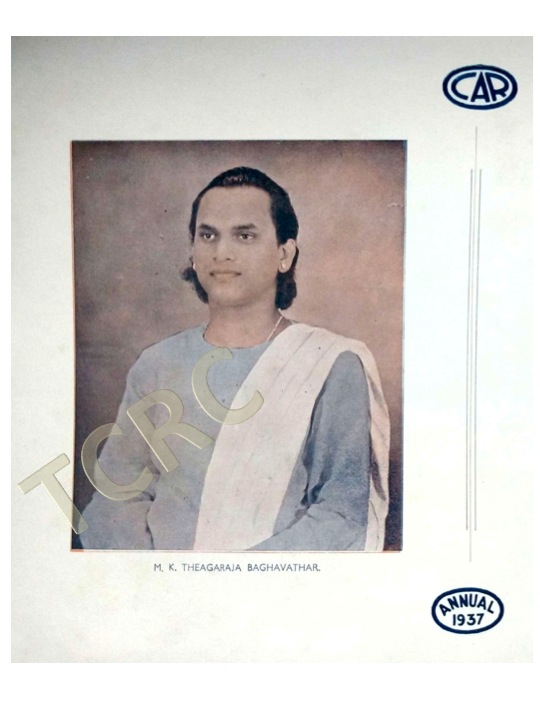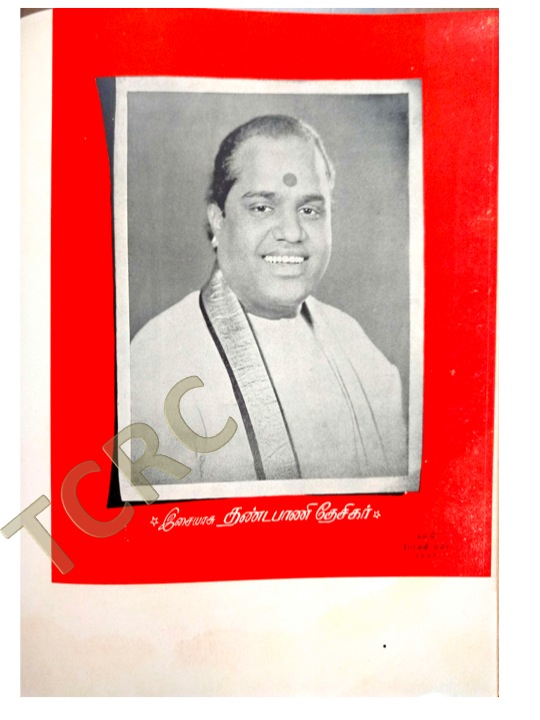By P.V. Gopalakrishnan
This edition is dedicated to Madras City as Madras Day is celebrated every year to commemorate August 22, 1639, the founding day of Madras City. It was then
East India Co who bought the land parcel, where Fort St. George stands today, from the local Nayak rulers. Settlements grew out of the fort slowly bringing together the villages around it marking the geographical expansion into a city called Madras.
This writer moved as a five year old, amidst great excitement, to this city in 1950, travelling in one of those old railway rakes with wooden seats on a South Indian Railway train (no reservation system in vogue then) , hauled by a pre-war work horse steam engine that made the entire Central Station messy with its noise, smoke & steam! Yes, our family migrated looking for greener economic pastures, shortly after Indian Independence. So, this writer holds fond memories as a child in the then laid back city of Madras with its heritage buildings, slow moving trams which then signified affordable urban mass mobility, few imported American and British automobiles that sparsely populated the streets & massive cinema hoardings.
In this Article we strive to look at Madras over the decades through the medium of cinema, in our humble respect to the city of Madras.
Madras was just not a city, but was a whole experience of its sights, sounds, smells, culture, cinema, music, beaches, temples, churches, mosques, heritage buildings, festivals, practices, heat, humidity & what not. If one were to compile sights & sounds of old Madras city, the clip should have obviously included the classical music concerts, Margazhi Bajanais. Black & white taxis, house sparrows known as chittukuruvis, omnipresent crows, the person rolling on the streets with the call of Govinda, Kudukuduppaikaran announcing good times, Boom boom mattukaran, Tirupathi kudais, blind school bands, street procession of local deities, Janvasam processions, political rallies, Funeral processions, Cone speakers, Kili josyam, mobile idiyappam seller, flower sellers near temples, ‘Saanai’ pidippavan (sharpening knives), mobile cotton ginner, door step butter vendor, personal goldsmiths and many more.
In late forties & early fifties, the pride of becoming an Independent Nation was all pervasive amongst all & the one big medium of those days’ cinemas celebrated it with reverence to the Father of the Nation! Films like ‘Naam Iruvar’ (1947) exuded National fervor emanating fresh from the self-pride & sense of gratuity to Mahatma Gandhi. Here is an old song set to the dance of a young ‘Kumari’ Kamala from the film.

Song book of Naam Iruvar with the page containing the song KARUNA MOORTHY PC: From the archives of TCRC
Those were the days when the fledgling Nation was struggling to take maiden steps having spent centuries under foreign rule. Those times commanded limited facilities, with post war famine induced ration shops & inflation. Here is a song, which was popular in those days, from the film ‘Andhaman Kaidhi’ rendered by T.V.Rathinam, which portrayed the subsisting inflation of those days through a housewife’s view. Please note a Five Rupee Note represented a big value in those days.
In those early days of post independence, ration & scarcity overwhelming plagued Madras City, as unscrupulous distributors & traders doing mass scale adulteration to make fast bucks. Those were the days prior to the State owned Food Corporations.
There was a satirical song “kalappadam kalappadam” rendered by S.C.Krishnan in Modern Theatres’ movie “Thirumbi paar” (1953) starring Sivaji Ganesan. The lines of this song are truly representative of adulteration spree in today’s context as well.
Mylapore, the cultural seat of the then Madras, was also synonymous with its population of leading legal luminaries from the pre independence days particularly concentrated in a small area called Palathope. This is a small street turning left from R.K. Mutt Road as it leads towards Mylapore Tank from Luz Corner, more or less opposite Thiru Mayilai Station. The reputation of Palathope being a powerhouse of prestigious lawyers is anything but presumptuous, as a number of luminaries from this street had graced court-rooms across India, right up to Supreme Court. As such Palathope earned Mylapore this famous epithet of being a ‘Lawyers’ Enclave’.
To commemorate Palathope’s such position, there was a well remembered song in Gemini’s ‘Miss Malini’ (1947), ‘’Mylapore vakkil athu mattu pon avaen’, sung by T.V.Rathinam, truly depicting the coveted status symbol that a girl is yearning to achieve in marriage, viz., becoming a daughter in law in a Mylapore vakil’s household of those times. S.Rajeswara Rao and Parur Anantharaman jointly composed this film’s score.
The film was based on a story titled “Mr. Sampath” written by the famous R.K.Narayan. This movie was also the debut film of Gemini Ganesan & Javert Seetharaman.
In the same movie there was another song, ‘Paadum Radio’ which outlines the comfort of Madras City life with its electric power, radio et al. There was counter in the same song which emphasizes what city life is devoid of.

Song book of Miss Malini with the page containing the songs MYLAPORE VAKKIL and PAADUM RADIO PC: From the archives of TCRC
The old-timers who grew up in the good old Madras, immediately before & soon after Indian Independence, would have fond memories of the city then. Of such nostalgic memories the pristine, unspoilt Beaches of the then Madras always beckon them. Right from 1937, when the All India Radio was established, public radio spots were a familiar feature of old Madras right through the forties and early fifties. In fact, the Historic broadcast of Jawaharlal Nehru’s famous midnight speech on August 15, 1947, was intently listened to by the Madras residents on the public address radio on the Beach.
In fact, when private radio sets were a luxury to the commoner, people met every evening at the beach to listen to the radio, which became a regular social event for the residents of Old Madras. These radio speakers were set up at various points across Old Madras then, like Santhome Beach & Panagal Park. But the most popular one was at the high court beach near the War Memorial, which disappeared in 1950 owing to the expansion of the Chennai Port Trust.
There was a film song, “Pattanathe parka parkka” from ‘En Manaivi’ (1942), as sequenced as sung by a rural girl. The song referred to the radio event as one of the marvels of science, and the lyrics read, ‘Sayangala nerathiley samudrakarai orathiley maayamana kambam onnu manushan pola paduthaiah!’ (The magic pole by the seashore, that sings like an entity). After all, simple rustic folks did wonder as to from where the music was flowing, then!
The actor in the clipping, R.Padma (then the Brand Ambassador for Lux Beauty Soap) had sung this song in her own voice. The lyrics were by T. K. Sundara Vaadhiyar and the music composer was R. Sudharsanam.
This song vividly portrays the ‘Awe’ factor that Madras City created with great fascination in the minds of rural populace. This also signified the advent of urbanization by migration of people from smaller cities & villages to Madras City.
Another song. which brought out the urge of rural folks to migrate to Madras City, in the wake of its ‘modern’ life & opportunities it offered, was ‘Pattanam thaan pokalamadi’ rendered by Sirgazhi & P.Suseela from the film ‘Engal veettu Mahalakshmi’ (1957), composed by Master Venu.

Song book of Engal Veettu Mahalakshmi with the pages containing the song PATTANAM THAAN POKALAMADI PC: From the archives of TCRC
However, the increasing urbanization with more migrating to Madras City only made people find the city less humane. Look at this street scene from the film ‘Parasakthi’ supporting this state of affairs, which the urban life had to offer to the commoner.
The set in which the sequence has been filmed has all the typical visuals that the old Madras street has had, viz, a Beat Madras Policeman in his uniform that prevailed then, a hand drawn Rickshaw, street vendors, a fire hydrant, a huge roadside post box, roadside ‘petti kadai’ etc.
‘Mappillai doay’ was a popular duet by A.M.Raja & P.Leela in the film ‘Manampola Mangalyam’ (1953) in the music of A.Rama Rao. Here the special reference is about the son in law from ‘Madras’ as a special reference. That shows the reverence this city earned then!
The song ‘Madras nalla Madras’ from the film ‘Anubhavi Raja Anubhavi’ too describes the ugly underbelly of Madras City through its funny lyrics & visuals , as Nagesh enacts the song.
‘Parappa Palaniyappa’ too takes a dig at the Madras City life through the eyes of a rustic bullock cart man, donned by MGR in ‘Periya Idathu PeNN’. Though most part of the song has been filmed in the backdrop of back projected visuals, in some shots you could see how the sixties’ Madras was so less crowded with clean streets.
Madras City was home to many News Papers & Periodicals both in English & Tamil. Madras had newspaper boys who used to hawk these publications on the pavements & streets, with an ever eager customer around to buy them. There was an interesting song from the “Samaya Sanjeevi” (1957), rife with nostalgia, sung by J.P.Chandrababu, ‘Paper…Paper’. It is very interesting to note the number of dailies & weeklies that were in circulation in the early Madras. Some of them like, The Mail, Swadesamithran, Kalkandu, Gundoosi, and Kadhir etc are no more today.
The song ‘Nenjirukkum engalukkum’ from the film ‘Nenjirukkum varai’ features a happy go lucky trio of Sivaji, Muthuraman & Gopalakrishnan dancing on the then traffic free Marina Beach Road, right from the Madras University till Gandhi Statue. In fact, if you observe, in the beginning of the song, you can even notice in the backdrop the wreckage of the Greek ship S.S.Stamatis that had run aground behind the Labour Statue in the ravaging storm of November 1966, which threw Madras out of gear!

Song book of Nenjirukkum Varai with the page containing the song NENJIRUKKUM ENGALUKKUM PC: From the archives of TCRC
Talking of Madras, one cannot overlook its lingo called ‘Madras Baashai’. This has been developed as an amalgam of borrowed words from Urdu & Hindi over the period. It has a generic name called ‘rickshawkaran baashai’ in the lighter sense and has been popularized by Chandrababu in films such as “Sabash Meena’ & ‘Sahodari’, besides Cho as a car mechanic in ‘Paar Magale Paar’.

Song book of Sagothari having the image of Chandrababu as Milkman and also the page containing synopsis through the Milkman’s perspective (Chandrababu with his Photo). PC: From the archives of TCRC
But it was V.Kumar composed ‘Vaa vadhyare vootande’ in the film ‘Bommalattam’, rendered by versatile Manorama that made the Madras Lingo indelible.
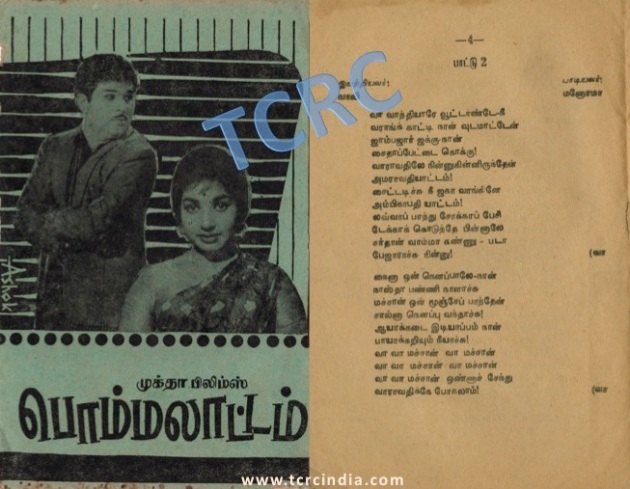
Song book of Miss Bommalattam with the page containing the song VAA VATHYARE VOOTANDE PC: From the archives of TCRC
In the early colonial days, there was only non-mechanised forms of transportation in Madras City such as hand pulled rickshaws, bullock carts & horse drawn jutkas. It was in 1894 Madras Electric Tramways Company first laid tracks in the city for Trams. The trams network served the Egmore, Customs House, Royapuram, Chindatharipet, Mount Road, Royapettah, Triplicane, Mylapore, Santhome, Purasawakkam & Washermanpet localities of Madras, till April 1953 when the government decided to call off tram service in Madras owing to technical feasibilities, after its 67 years of service in the city. While Trams operated in Madras, it had encountered many a hiccup, but when the service was finally called off it catered to 125000 passengers per day over the 26 km net work it operated in Madras. The trams were too slow at 7 km per hour, with the tram driver making a bell sound by his foot to alert those who cam by its tracks!
Motor bus services first appeared in Madras in 1920. In the early days, Post Independence, the government buses that plied in Madras City were all blur coloured & the fleet included the old buses from Ford & Chvrolet stable. In fact, during the Congress Meet at Avadi in 1955, many trucks were temporarily converted & ran as public transportation. Then came the Red buses (then popularly referred as ‘Red Lady’) from Leyland, U.K & Daimler Benz, and Germany. They all bore the inscription “Govt. Transport, Madras”. Later in due course, it became “State Transport, Madras”. Only during the DMK regime they were all formed as Transport Corporations & christened as Palawan, Azhagiri etc. There were Tiger Leyland buses with their majestic appearance & comfort seating. But soon they were sent to Delhi as the Madras roads were too small to operate them.
There were metered taxi services from the early post independent days in Madras. The smaller taxis, mostly constituting Morris Minors, Baby Hindustan, Standard Ten, Herald were called ‘Baby Taxis’ offering a lesser tariff. The roomier Fords, Chevrolets and the like were normal taxis that cost a little extra. Later Ambassadors & Fiats monopolized the taxis.
Here is a clip from ‘Sadhu Mirandal’ featuring Nagesh as a taxi driver.

An advertisement of the Film Sathu Mirandal from the magazine NARADHAR Dec 1965 depicting Nagesh as Taxi driver with his Taxi PC: From the archives of TCRC
The old Madras had its own charm. There were no food courts but there were famous eateries such as Ambls Cafe, Modern Cafe, Ramakrishna Lunch Home, Ratna Cafe, Rayar’s Café & Woodlands. None can forget the Peach Melba at Buharis where jukeboxes played your favourite film music.
There were no Malls but there appeared seasonal Exhibitions at Teynampet Grounds & Island Grounds.
The city boasted of many heritage structures including Iron Bridge, War Memorial, University Bldgs., Police HQ Bldg near A.I.R. Vivekananda House, Museum Theatre.
There were no Corporate Hospitals like Apollo or even Poly Clinics but there were small neighborhood doctors who knew personally your family members. There was even a 24×7 Pharmacy at Agurchand Mansions on Mount Road called ‘Sahib Singh’s which dispensed medicines at wee hours too.
There were fewer vehicles on the road & there was just one subway near RBI and no flyovers. Ranganathan Street was never crowded.
With all that the old Madras had its own bewitching aspects.

